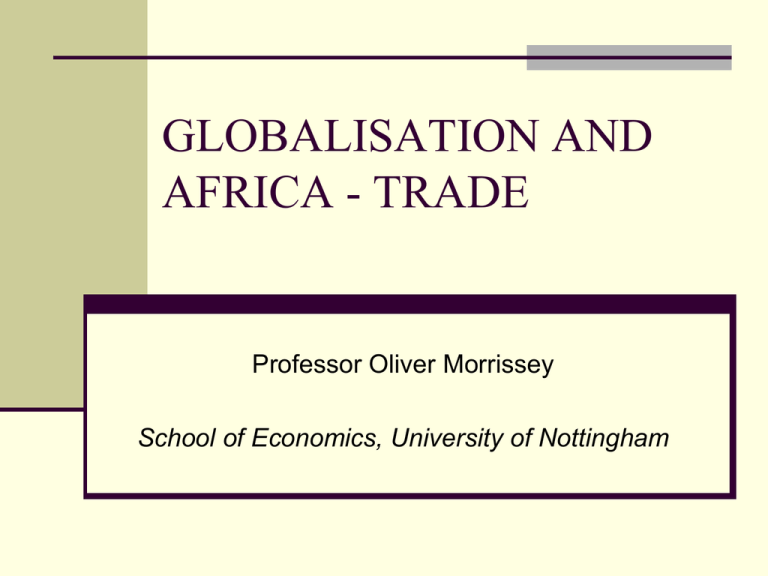morrisseypresentation-Schools2006
advertisement

GLOBALISATION AND AFRICA - TRADE Professor Oliver Morrissey School of Economics, University of Nottingham Context African countries have liberalised trade policies, but exports have not grown significantly. Arguments: A.‘Openness is good for growth’ (encourages competitive exports) B. Free trade exposes countries to cheap imports that undermine economy. What is the problem? Some issues: Declining share in World trade Declining export prices Access to World markets Structure of trade Trade policy and trade performance Declining share in World trade Table 1: Regional Shares of World Merchandise Trade, 1990 and 2000 Region North America Western Europe Asia Latin America Africa Source: WTO (2001). Exports (%) 1990 15.4 48.3 21.8 4.3 3.1 2000 17.1 39.5 26.7 5.8 2.3 Imports (%) 1990 18.4 48.7 20.3 3.7 2.7 2000 23.2 39.6 22.8 6.0 2.1 Rising volume of exports Volume Index of Exports, 1990-2002 (1990=100) World SSA LDCs 1990 100.0 100.0 100.0 1994 126.5 104.8 132.4 1998 177.6 127.0 186.5 Calculated from UNCTAD Statistical Yearbook, 2004 2002 208.2 161.9 216.2 But value not pace Figure 1: UNCTAD Volume and Value Index of Exports of SSA, and Terms of Trade, 1980-2002 (1980=100) 180.0 160.0 Volume index of exports Value index of exports Terms of trade 140.0 120.0 100.0 80.0 60.0 1980 1981 1982 1983 1984 1985 1986 1987 1988 1989 1990 1991 1992 1993 1994 1995 1996 1997 1998 1999 2000 2001 2002 Source: UNCTAD Handbook of Statistics 2004, on cd rom. Perhaps it is what they export Table: Sector % Share in Regional Total Exports, 2002 Region North America Western Europe Asia Latin America Africa Agriculture 10.7 9.4 6.6 19.3 15.8 Source: WTO (2003). Minerals 7.2 6.9 7.1 20.3 55.1 Manufactures 76.9 80.7 83.6 59.5 25.2 Commodity Prices Table: Trends in Primary Commodity Export Prices (1995 = 100) Commodity All Primary Food and Beverages Cereals Sugar Coffee Cocoa Tea Agriculture Raw Materials Cotton Minerals Copper Crude Petroleum Source: WTO (2003). 1998 79 89 79 73 82 117 145 76 67 74 56 76 2000 116 77 67 66 50 63 151 81 60 82 62 164 2001 106 78 70 67 35 76 121 77 49 74 54 141 2002 106 79 80 56 36 124 109 78 47 72 53 145 But trade is important Table: Trade Performance in Africa Imports/GDP 90-92 98-00 Exports/GDP % 90-92 98-00 change % change Regions North Africa (4) 34.1 32.1 -5.9 29.5 29.9 1.4 West Africa (10) 32.3 38.4 18.9 26.5 29.5 11.3 Central Africa (6) 27.3 30.8 12.8 23.6 28.4 20.3 East Africa (5) 33.4 35.5 6.3 23.0 26.1 13.5 Southern Africa (4) 30.6 37.2 21.6 26.6 30.8 15.8 Notes: Columns give average import/GDP and exports/GDP ratios averaged over 1990-92 and 1998-2000, and percentage change in ratios. Structural features Depend on a narrow range of primary commodities. In the late 1990s, 39 African countries depended for more than half of their export earnings on just two primary commodities. Declining, at least relatively, export prices. Difficult to increase production quickly (export supply response). Natural barriers to trade (transport costs) High transport costs Global Patterns of Transport Costs, by Region, selected years Region Sub-Saharan Africa Asia Middle East Latin America Western Europe cif/fob ratio 1980 1990 1.112 1.115 1.093 1.086 1.124 1.103 1.094 1.091 1.056 1.053 1994 1.157 1.086 1.108 1.083 1.047 The Gains from Trade Trade does not guarantee net benefits, rather it provides opportunities. exports access the global market and permit increased production. trade encourages efficient allocation of resources. imports increase consumption possibilities. trade contributes to economic growth by generating long-run gains. Are not a fee lunch Trade also presents challenges, and producers must be enabled to respond Exporters face competitors on a world market Competition from imports challenges local producers. Imports may increase faster than exports, resulting in a balance of payments deficit that imposes macroeconomic adjustment costs on the economy. In brief Globalisation has had a limited effect on increasing African trade because… Weak policy (especially towards agriculture) Wrong products and limited diversification High trade costs Lack of trust in Governments Low productivity Not all bad news There are successes: Mauritius has done well from exporting sugar and garments to the EU (but …) Botswana has managed its diamonds well (but the scourge of AIDS) Uganda has done quite well since the early 1990s, but with limited diversification beyond coffee. Questions Should Africa liberalise more? Will the WTO help? What can Africa do? Facilitate trade Reduce trade costs The manufacturing problem The agriculture dilemma Supply raw materials to China?




